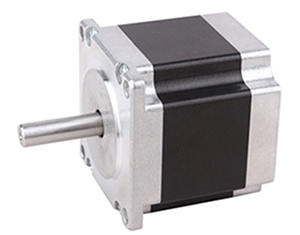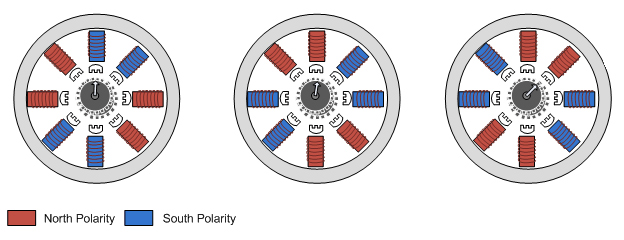Working Tips for Stepper Motor
1. When the same stepper motor works with different drive schemes, the torque-frequency characteristics are also very different.
2. When the stepper motor is working, the pulse signal will be added to each phase winding in turn in a certain order (the ring distributor in the stepper motor driver controls the way the winding is energized and de-energized).
3. Unlike other motors, the nominal rated voltage and rated current of a stepper motor are only reference values. Because the stepper motor is powered by pulse, the power supply voltage is its highest voltage, not the average voltage. Therefore, the stepper motor can work beyond its rated value range. However, when choosing, it should not deviate too far from the rated value.
4. The stepper motor does not accumulate errors: The accuracy of the general stepper motor is 3%-5% of the actual step angle, and it cannot be accumulated.
5. The maximum temperature allowed on the outer surface of the stepper motor: If the temperature of the stepper motor is too high, the magnetic material of the motor will be demagnetized first, resulting in a drop in torque and even loss of step. Therefore, the maximum temperature allowed on the outer surface of the motor should depend on the demagnetization point of different motor magnetic materials. Generally speaking, the demagnetization point of magnetic materials is above 130 degrees Celsius, and some are even as high as 200 degrees Celsius, so the external temperature of the stepper motor is completely normal at 80-90 degrees Celsius.
6. The torque of the stepper motor will decrease with the increase of the speed: When the stepper motor rotates, the inductance of each phase winding of the motor will form a back electromotive force. The higher the frequency, the greater the back electromotive force. Under its action, the phase current of the motor decreases with the increase of frequency (or speed), resulting in a decrease in torque.
7. The stepper motor can operate normally at low speed. However, if the frequency is higher than a certain frequency, it will not start, and there will be a whistling sound. The stepper motor has a technical parameter: No-load starting frequency. This frequency refers to the pulse frequency that the stepper motor can start normally under no-load conditions. If the pulse frequency is higher than this value, the motor cannot start normally, and may cause lost steps or stalls. In the case of load, the starting frequency should be lower. If the motor is to rotate at a high speed, the pulse frequency should have an acceleration process. That is, the starting frequency is low, and then the starting frequency is increased to the desired high frequency according to a certain acceleration. (The motor speed is increased from low speed to high speed.)

8. The power supply voltage of the hybrid stepper motor driver generally has a wide range (for example, the power supply voltage of IM483 is 12-48 VDC). The power supply voltage usually needs to be selected according to the working speed and response requirements of the motor. If the motor has a higher operating speed or a faster response requirement, the voltage value is also higher. However, it should be noted that the ripple of the power supply voltage cannot exceed the maximum input voltage of the driver, otherwise the driver may be damaged.
9. The current of the power supply is generally determined according to the output phase current I of the stepper motor driver. If a linear power supply is used, the power supply current can generally be 1.1 to 1.3 times of I. If a switching power supply is used, the power supply current can generally be 1.5 to 2.0 times of I.
10. When the offline signal is low, the current from the driver to the motor is cut off, and the motor rotor is in a free state (offline state). In some automation equipment, if it is required to directly rotate the motor shaft (manual mode) when the drive is powered off, you can set the signal to low to make the motor offline for manual operation or adjustment. After manual completion, the signal can be set high again to continue automatic control.
11. If you want to use a simple method to adjust the rotation direction of the two-phase stepper motor after power on, you only need to reverse the A+ and A- (or B+ and B-) wirings of the stepper motor and the stepper motor driver.
12. The four-phase hybrid stepper motor is generally driven by a 2 phase stepper driver. Therefore, when connecting, you can use a series or parallel connection method to connect the four-phase motor into two-phase in operation. The series connection method is generally used in occasions where the motor speed is low. At this time, the required driver output current is 0.7 times the motor phase current, so the motor generates less heat. The parallel connection method is generally used in occasions where the motor speed is high (also known as high-speed connection). In this case, the required driver output current is 1.4 times the motor phase current, so the stepper motor generates more heat.


